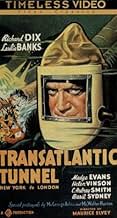VALUTAZIONE IMDb
6,0/10
1076
LA TUA VALUTAZIONE
Un team di scienziati e ingegneri internazionali tenta di costruire un tunnel sotto l'oceano.Un team di scienziati e ingegneri internazionali tenta di costruire un tunnel sotto l'oceano.Un team di scienziati e ingegneri internazionali tenta di costruire un tunnel sotto l'oceano.
- Regia
- Sceneggiatura
- Star
- Premi
- 2 vittorie totali
George Arliss
- Prime Minister of Great Britain
- (as Mr. George Arliss)
Walter Huston
- President of the United States
- (as Mr. Walter Huston)
James Carew
- Jim Barton
- (non citato nei titoli originali)
Pat Fitzpatrick
- Geoffrey - As a young child
- (non citato nei titoli originali)
Jacqueline Giovanni
- Young Girl
- (non citato nei titoli originali)
Helen Haye
- Oil Magnate
- (non citato nei titoli originali)
Bryan Herbert
- American Reporter
- (non citato nei titoli originali)
Dennis Hoey
- Worker
- (non citato nei titoli originali)
Recensioni in evidenza
Finally saw this movie after many years of eager anticipation only to find myself bored. I have to agree with Maltin's summary of the two-dimensional characterization of the players in this movie. The characters in this movie do nothing more than bicker and argue.
The movie was released in Britain in 1935. A darkening time for Europe was on the horizon with Adolph Hitler's rise to power in Germany. The characters in the movie hint at using the tunnel for uniting the "English" speaking people of the world; not to mention the transportation of armaments to Britain should war break out! Perhaps this movie was supposed to quell the fears of the British by offering an avenue of escapism in the promise of new and revolutionary technology (ie. the Radium Drill!) to avert war.
Never the less the movie does utilize futuristic sets and models that were ahead of their time and still hold their own today. Transportation historians will find this movie interesting. 6.5 out 10.
The movie was released in Britain in 1935. A darkening time for Europe was on the horizon with Adolph Hitler's rise to power in Germany. The characters in the movie hint at using the tunnel for uniting the "English" speaking people of the world; not to mention the transportation of armaments to Britain should war break out! Perhaps this movie was supposed to quell the fears of the British by offering an avenue of escapism in the promise of new and revolutionary technology (ie. the Radium Drill!) to avert war.
Never the less the movie does utilize futuristic sets and models that were ahead of their time and still hold their own today. Transportation historians will find this movie interesting. 6.5 out 10.
The concept of the movie is very basic: the building of a tunnel connecting the eastern United States with the island of Great Britain. If this were actually possible, it would probably have been done long before now -- but this film is an excellent portrayal of the possibilities. It's quite entertaining for not only fans of old movies, but for history buffs as well -- and even students of transportation should enjoy it!
Quite similar to "Just Imagine" from 1930, where they try to give some insight into what the future will look like. Some cool inventions, like picture telephones, airplanes that can hover like the Osprey, and the "radium" tunnel drill. They even talk about the man who "built the Channel Tunnel in 1940" . Another viewer mentions that at the end, they saw cars driving into the tunnel, but I never saw that. I saw the 92 min, 40 sec version on TCM in March 2008, so it seems there's a minute or two missing from the TCM print. "Tunnel" stars Richard Dix and Leslie Banks, with various other co-stars. It combines the challenge of building a tunnel (where the shareholders keep pulling the financing) with a troubled family life. They even take a couple swipes at millionaires. George Arliss, star of the silents, appears as the British Prime Minister. The big shot shareholders take a minute to point out that the lead engineer is "just another employee, and he must remember that!" When he asked why they couldn't tell him what was wrong over the telephone, they insisted he come in person... I wondered if they were avoiding saying things over the air, but they don't indicate that (this was just prior to WW II) I also felt bad for the workers down in the tunnel -- heavy equipment is being pulled up on cable, but no-one is wearing hardhats. Fun to watch if you keep in mind that it was made in 1935. I could have done without the silly side portraits of the key characters at the last couple minutes, but someone must have felt that added something. Entertaining early science fiction.
A team of international scientists and engineers attempts to build a tunnel under the ocean.
The story was written by the amazing Curt Siodmak, based on the 1913 novel "Der Tunnel" by Bernhard Kellermann. Interestingly, "Der Tunnel" had already been filmed three times before, once as a German silent, "Der Tunnel" (1915), and then as two sound films "Der Tunnel" (German) and "Le Tunnel" (French), both released in 1933, and both directed by Curtis Bernhardt. The British version today remains the only one easily available.
Suggestions for such a structure actually go back to Michel Verne, son of Jules Verne, who wrote about it in 1888 in a story entitled "Un Express de l'avenir" (An Express of the Future). This story was published in English in Strand Magazine in 1895. As recently as the 1960s, the idea was again proposed, but then using vacuum tubes rather than more traditional modes of transport.
As for the film, it is worth seeing, if for no other reason than to get a feel for British science fiction in the 1930s. This approach seems much different than the boomin science fiction of the 1950s.
The story was written by the amazing Curt Siodmak, based on the 1913 novel "Der Tunnel" by Bernhard Kellermann. Interestingly, "Der Tunnel" had already been filmed three times before, once as a German silent, "Der Tunnel" (1915), and then as two sound films "Der Tunnel" (German) and "Le Tunnel" (French), both released in 1933, and both directed by Curtis Bernhardt. The British version today remains the only one easily available.
Suggestions for such a structure actually go back to Michel Verne, son of Jules Verne, who wrote about it in 1888 in a story entitled "Un Express de l'avenir" (An Express of the Future). This story was published in English in Strand Magazine in 1895. As recently as the 1960s, the idea was again proposed, but then using vacuum tubes rather than more traditional modes of transport.
As for the film, it is worth seeing, if for no other reason than to get a feel for British science fiction in the 1930s. This approach seems much different than the boomin science fiction of the 1950s.
THE TRANSATLANTIC TUNNEL is a sci-fi film set in the near future. The story is about a joint American-British effort to build this tunnel. Additionally, the toll this takes on the men (in particular the chief engineer) and the behind the scenes machinations are explored.
This is a really neat sci-fi movie in many ways. While the idea of a transatlantic tunnel is ridiculously far-fetched, the special effects for this British film are amazingly realistic and well executed. It's really too bad, then, that the soap opera built around it is poor. However, because the film is so astounding to look at, it's still well worth a look.
The British film makers enlisted Richard Dix for the lead in this film. He was a big name for the time and he would presumably bring American audiences to see this film. Whether or not this worked, I have no idea, but although I like Dix in other films, here he isn't particularly distinguished. This would be more obvious had it not been that many of the British cast were pretty dreadful. And, because the dialog was so poor, it only made this seem worse.
As I said, this is all pretty sad, as the special effects were great. Seeing giant television sets, videophones, cool futuristic cars and the tunnel itself were all absolutely amazing. In fact, it's one of the best sci-fi films of the time and this aspect of the film alone merit a 9 or 10--not bad for a relatively low budget film.
Overall, it's a great curio that you can enjoy provided you can wade through the soapy story.
This is a really neat sci-fi movie in many ways. While the idea of a transatlantic tunnel is ridiculously far-fetched, the special effects for this British film are amazingly realistic and well executed. It's really too bad, then, that the soap opera built around it is poor. However, because the film is so astounding to look at, it's still well worth a look.
The British film makers enlisted Richard Dix for the lead in this film. He was a big name for the time and he would presumably bring American audiences to see this film. Whether or not this worked, I have no idea, but although I like Dix in other films, here he isn't particularly distinguished. This would be more obvious had it not been that many of the British cast were pretty dreadful. And, because the dialog was so poor, it only made this seem worse.
As I said, this is all pretty sad, as the special effects were great. Seeing giant television sets, videophones, cool futuristic cars and the tunnel itself were all absolutely amazing. In fact, it's one of the best sci-fi films of the time and this aspect of the film alone merit a 9 or 10--not bad for a relatively low budget film.
Overall, it's a great curio that you can enjoy provided you can wade through the soapy story.
Lo sapevi?
- QuizOne of the plot elements that crops up in the movie is a volcanic area that the tunnelers run into about halfway across the Atlantic. This makes sense, as the Mid-Atlantic Ridge is a very active area. The neat part in relation to the movie is that while the existence of a "Ridge" on the seafloor was known at the time, it was not known that it was so active. It wasn't until the Heezen/Ewing/Tharp mapping of the ocean floor in the 1950s that people discovered that Seismic activity and "Seafloor Spreading" due to magma seepage were going on. That was about 20 years after the makers of the film surmised Magma pockets near the Mid-Atlantic.
- BlooperAlthough the story takes place over a period of about twenty years, none of the principal players shows any sign of aging, despite all the ordeals encountered.
- Citazioni
Richard 'Mack' McAllan: There are bigger things than money.
Airways Magnate: We don't deal in 'em.
- Curiosità sui creditiAt the end of the opening credits, a card comes up with "Gaumont-British Picture Corpn. Ltd. were fortunate in securing the services of Mr. George Arliss and Mr. Walter Huston for the parts of Prime Minister of Great Britain and President of the United States."
- ConnessioniEdited from Il tunnel (1933)
I più visti
Accedi per valutare e creare un elenco di titoli salvati per ottenere consigli personalizzati
Dettagli
- Tempo di esecuzione1 ora 34 minuti
- Colore
- Proporzioni
- 1.37 : 1
Contribuisci a questa pagina
Suggerisci una modifica o aggiungi i contenuti mancanti

Divario superiore
By what name was The Tunnel (1935) officially released in India in English?
Rispondi


































